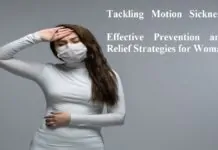No one is immune to motion sickness. In the world of travel and adventure, where every moment can be transformed into an unforgettable experience, motion sickness can become an unwelcome companion. This physiological reaction, sometimes known as seasickness or motion sickness, has the potential to dampen spirits and constrain opportunities for many women.
However, understanding the fundamentals and effective methods for the prevention and relief of motion sickness can make every journey more comfortable and fulfilling.
Table of Contents
Motion Sickness Explained: Triggers and Unpleasant Sensations
You experience motion sickness when your brain can’t keep up with processing the changing signals it receives from the eyes, ears, and body—the visual, vestibular, and somatosensory systems. The vestibular system is located in the inner ear and plays a primary role in balance and coordination.
However, when you’re riding on a rollercoaster or sitting in the backseat of a car, the vestibular system is sending your brain conflicting signals—your surroundings are in motion, but your body is still.
Some of us are more sensitive to the effects of motion. Women, children under twelve, and people with a certain genetic disposition are more prone to motion sickness and are likely to experience more severe symptoms.
If you’ve ever suffered from motion sickness, you know dizziness, sudden stomach upsets, cold sweats, and the dreaded feeling of not being able to move properly.
Other common symptoms of motion sickness include nausea, vomiting, loss of appetite, increased salivation, pallor, dizziness, headache, rapid breathing, and fatigue.
Personalized Approaches: Adapting to Motion Sickness Based on Your Period Cycle
The connection between the menstrual cycle and motion sickness is rooted in a woman’s hormonal background. Biological changes occurring in different phases of the cycle can impact the body’s perception of motion.
To gain a deeper understanding of the body’s response, keeping a menstrual calendar is valuable. Note the onset and duration of menstruation, along with the cycle phases. This approach helps identify days when motion sickness may be more pronounced.
Particularly crucial is observing variations in symptoms during different cycle phases. During ovulation and the premenstrual syndrome (PMS) period, motion sickness symptoms may intensify. Changes within the body, such as fluctuations in estrogen and progesterone levels, can influence the response to motion.
Employing adapted techniques during different cycle days can assist in managing motion sickness. Gentle seating positions during transportation, incorporating ginger into the diet, and practicing mindful breathing can alleviate discomfort.
Understanding that every individual’s body is unique is essential. Monitoring personal observations and reactions enables a more effective adaptation of approaches according to cycle phases. By tracking symptoms and responses, women can more easily navigate motion sickness and make menstruation days more comfortable.
Motion Sickness and Pregnancy: Navigating Discomfort Safely
Motion sickness can become a more complex issue during pregnancy. Many expectant mothers experience heightened sensitivity to motion, particularly in the first trimester. This is due to hormonal changes and the body’s adaptation to the new state.
To alleviate motion sickness during pregnancy, it’s important to exercise caution when choosing seating positions in transportation. Priority should be given to stable seats that minimize movements. Traveling in fresh air and taking regular breaks can also be beneficial.
Incorporating ginger into your diet may serve as a useful remedy for easing motion sickness symptoms. This natural approach has a proven effect on nausea and vomiting. However, it’s always advisable to consult with a healthcare professional before making dietary changes.
Applying mindful breathing techniques can also reduce discomfort. Deep and slow inhalations can help release tension and focus attention on breathing, thus reducing the sensation of nausea.
Every pregnancy is unique, and the response to motion sickness can vary. Pay attention to your body’s reactions, utilize approaches that work best for you, and don’t hesitate to consult a healthcare provider regarding any concerns related to motion sickness and your well-being.
Motion Sickness Prevention: Effective Strategies for Travel Comfort
When it comes to travel comfort, there are several effective methods to reduce the risk of motion sickness and enhance your well-being. Choosing your seating position is a key aspect. Give preference to stable spots in transportation, such as front rows, window seats, or eye-level seats. This will help you minimize the impact of movements.
Maintain your focus on the horizon, avoiding excessive attention to moving objects outside the window. This can decrease the likelihood of discomfort. Gentle movements in transportation also play a role. Avoid sudden head turns and continuous motions that could worsen symptoms.
Mastering deep and slow breathing techniques can aid in reducing tension and alleviating discomfort. Incorporating ginger into your diet is a natural solution for mitigating motion sickness symptoms. Try ginger tea, and candies, or add it to your food. Maintain a healthy diet and proper hydration, avoiding excessive consumption of food and alcohol. Keep in mind regular water intake.
Allocating time for rest and relaxation during the trip is essential. Implementing relaxation methods like meditation and listening to soothing music can help reduce anxiety and discomfort.
Each individual is unique, and methods can vary in effectiveness. Experiment, choose approaches that suit you best, and create your own toolkit to combat motion sickness.

















